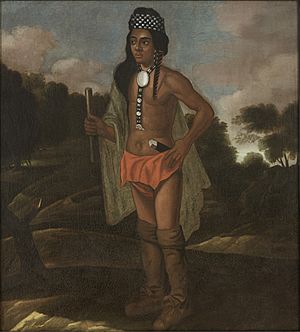Ninigret facts for kids
Quick facts for kids
Ninigret
|
|
|---|---|

Ninigret in 1681 (collection of Rhode Island School of Design Museum)
|
|
| Niantic leader | |
| Personal details | |
| Resting place | "Burying Hill" near Charlestown, Rhode Island |
| Relations | Nephew Miantonomo |
| Children | Son Ninigret; daughter |
| Nickname | Juanemo |
Ninigret (also known as Juanemo) was a powerful leader, or sachem, of the eastern Niantic tribe. He lived in New England, mainly in what is now Rhode Island, during the time colonists first arrived. He was born around 1610 and died in 1677.
In 1637, Ninigret joined forces with the colonists and the Narragansetts. They fought together against the Pequot tribe. Ninigret is remembered for keeping his Niantic people out of King Philip's War. This was a big war where colonists fought to protect their homes from some other Native American tribes.
Contents
Biography of Ninigret
Early Life and Alliances
Ninigret was the son of Sachem Saccious. He was also related to other important leaders like Miantonomo and Harman Garrett. The colonists first knew him as Janemo. He was the main leader of the Niantics, a tribe connected to the Narragansett people.
Ninigret did not take part in the Pequot War of 1632. However, he helped the colonists in the Pequot War of 1637. About a year after Miantonomo died, Ninigret made a plan. He wanted to make the colonists leave the area. He sent a message to Waiandance, a leader on Long Island, to ask for his help.
Waiandance, however, tied up the messenger. He then sent the messenger to the fort at Saybrook. From there, the messenger was sent to Hartford. But the group had to stop at Shelter Island, where the messenger managed to escape.
Challenges and Conflicts
In 1644, a group of colonies called the New England Confederation formed an army. Their goal was to protect their ally, Uncas, from Ninigret. Captain Humphrey Atherton led this group into Narragansett land. He wanted to make new agreements with the tribes.
Ninigret and his men stopped their attack and left. Captain Atherton marched into Ninigret’s home, called a wigwam. He threatened Ninigret's life. This action worked, and Ninigret reportedly begged for his life. He promised to follow the colonists' rules.
During the winter of 1652-1653, Ninigret stayed with Dutch colonists in Manhattan. He also spent time with western Native American tribes. The New England colonists thought Ninigret was planning against them. They believed he was gathering guns and making alliances with other strong tribes.
Ninigret started a war against the Long Island tribes. These tribes were protected by the New England colonists. In September 1654, the Connecticut colonists demanded that Ninigret come to Hartford. They also wanted him to pay a long-overdue payment, or tribute, from his Pequot subjects.
Ninigret refused to appear. He sent back a proud and defiant answer. The Massachusetts Bay Colony then declared war on him. They sent 270 foot soldiers and 40 horsemen. Major Simon Willard led these troops. Willard was told to go to Ninigret's area. He was to demand the tribute and insist that Ninigret stop fighting the Long Island tribes.
When the troops got close, Ninigret ran away to a distant swamp. The soldiers did not follow him. The Pequots who had been under Ninigret's control were then placed under the care of Harmon Garrett.
Later Years and Legacy
On October 13, 1660, Ninigret gave land in Pettequamscot to the Colony of Rhode Island. He did not take part in King Philip's War (1675-1676). Because of this, his tribe avoided the destruction that happened to other tribes. It is believed that his remains are buried at a place called Burying Hill near Charlestown, Rhode Island.
The Puritans tried to convert the Narragansetts and Niantics to Christianity. But they had little success. Roger Williams wrote about how discouraged he was. Thomas Mayhew asked Ninigret if he could preach to his tribe. Ninigret replied, "Go and make the English good first."
Ninigret's Successors
Ninigret's daughter became the leader after him. When she died, her half-brother, also named Ninigret, took over. In 1709, the younger Ninigret gave a large part of his people's land to the Rhode Island colony. This land transfer later caused problems for the Niantics.
The younger Ninigret died around 1722. He left behind two sons, Charles Augustus and George. Charles Augustus died soon after, leaving a baby son. Some of the tribe accepted the baby boy as their leader. But another part of the tribe followed his uncle George. George took full control of the government in 1735.
George's son, Thomas Ninegret, became chief in 1746. He sold more Niantic lands to the Rhode Island colony. This made his people unhappy, and some tried to remove him from power. They asked for help from Sir William Johnson. He was the colonial leader for Native Americans in the Northeast.
They argued that the lands Thomas Ninegret sold were needed to support families. These were families of men who had died serving the English king in the French and Indian War. In one letter to Johnson, they asked if they could remove a leader. They wrote, "As it was in the power of the nation to put him in, we think it in the power of the nation to turn him out." The disagreement went on for several years. But Rhode Island eventually got the lands.
A small group of Niantic people were still living in Rhode Island in 1812. The tribe no longer exists as a separate group. However, some descendants still live in New England today.
Places Named After Ninigret
- Ninigret National Wildlife Refuge
- Fort Ninigret
- Ninigret Pond
- Ninigret Park
- Ninigret Beach
- Ninigret Cove (in Quonochontaug Pond, near Charlestown/Westerly border)
Legacy
Local oysters are called Ninigret Nectars. They are smaller than most other oysters found in New England.


